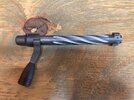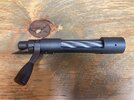sage5907
Member
Yes, I'm into the Winchester featherweight rifle also and you're well on your way. I found a used 6.5 Swede barrel on eBay about 2 years ago and I bid $180 just before the auction closed and I thought I had it locked up but someone smarter than me outbid me in the last minutes. I was really disappointed. You may have to buy a rifle in a different caliber and then change the barrel. If you see a 6.5 Swede barrel bid high and then look for a rifle later. It costs about $120 to change a barrel.I have done the same with Winchester Featherweight rifles, but only up to 3 so far.
Rebore from 270 to 35 Whelen, 30-06, and 223.
I’m looking for a 6.5 Swede but no luck yet.
These are late 1980’s vintage. Beautiful rifles and fit me perfectly.
Last edited:



